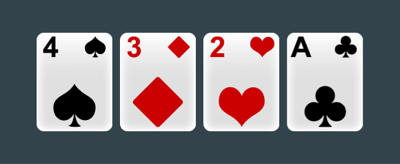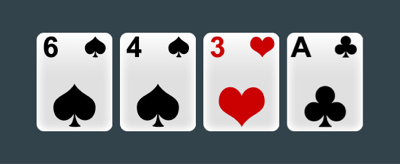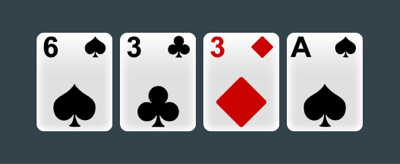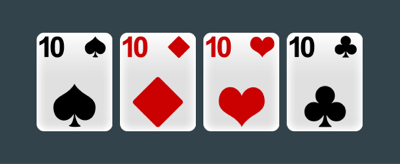Introduction
Badugi is a draw poker variation similar to triple draw, featuring lowball hand values. Although many people have recognized the similarities to the South Korean word "baduk," which means "black and white pattern," the origin of the card game Badugi is unclear.
The betting structure and overall play of the game are identical to that of a regular blinds-based poker game, however, unlike traditional poker, players' hands only contain four cards at any given time. Players can trade zero to four cards from their hands for new ones from the deck during each of the three drawing rounds to build the best Badugi hand and win the pot. Although it has many similarities to other draw games, such as 2-7 Triple-Draw Lowball, Badugi uses a unique system for determining the winning hand.
How to Play Badugi
Dealing
Badugi is a game that can be played with a fixed limit, a pot limit, or a half-pot limit. After each hand, the turn to deal (or have the dealer button if there is a non-playing dealer) passes clockwise, just like in any other poker game. If there are more than two players, the player to the left of the dealer places a small blind, and the player to the left of the next player places a big blind, which is usually twice as big as the small blind. The dealer places a small blind while the dealer's opponent places a big blind in a "heads up" (two-player) game.
The dealer deals four cards to each player, one at a time, clockwise, face down, and the players examine their hands. The betting round is then started by the player on the left of the big blind. The big blind is normally equal to the minimum bet. The player who placed the big blind is allowed to bet if none of the other players do anything other than call.
Drawing
The players have three rounds of drawing opportunities to improve their hands. Each player decides the number of cards they want to discard and draws that number of cards to the pile. They then receive an equal number of replacement cards starting with the first active player to the dealer's left and continuing clockwise. Players can swap any number of cards from zero to four; "standing pat" means not exchanging any cards.
Betting
After each round of drawing, after each active player has had a chance to draw cards, a new betting round begins, which is initiated by the first active player to the left of the dealer. As a result, there are up to four betting rounds in total: before the first draw and after each of the three drawing rounds. In a fixed limit game, the amount of the bet doubles after the second draw, so in big bets in the third and fourth betting rounds.
The Showdown
If just one active player remains at any point throughout the game, that player takes the pot without displaying any cards.
If there is more than one active player, player at the end of the last betting round, a showdown occurs in which the active players display their cards in turn. The last player who bet or raised in the final betting round, or the first active player to the dealer's left if all checked in the final betting round starts to show their hand.
Players must display all four cards, even if they only have a three-card, two-card, or one-card hand due to duplicate ranks or suits. The cards speak for themselves, and the best hand wins the pot. If two or more players have the same best hand, they split the pot evenly.
Badugi Hand Rankings
Some rules for Badugi:
1. Aces are always low
2. When comparing hands, all the cards in each hand must be different in suit and rank. If a player holds more than one card of the same suit or two or more cards of the same rank, some cards must be removed to form a valid hand.
3. Because there are no straights in Badugi, four cards in a row do not weaken your hand
4. Only the lowest card of the same suit counts if you have two or more of the same suits
5. The same is valid for paired cards. Only one of your cards counts if you have a pair
Example Hands
1. Badugi
Four unpaired cards of different suits.

If more than one player hold a Badugi, the player who has the lowest high card wins.
2. Three-Card Hand
Three unpaired or unsuited cards, plus one that pairs or is suited with one of the other three.

3. Two-Card Hand
Two unpaired cards of different suits, with two additional cards that pair with at least one of the other two.

4. One-Card Hand
Four of a kind is the worst possible hand (or four cards of the same suit).
